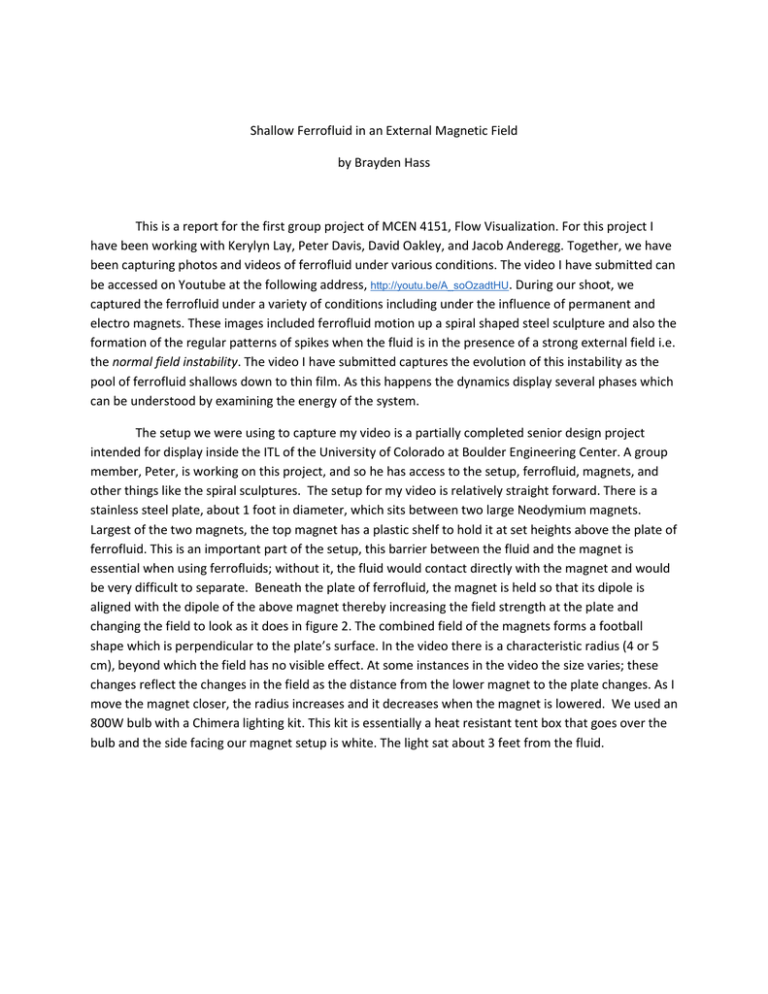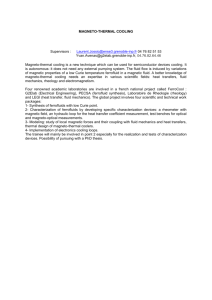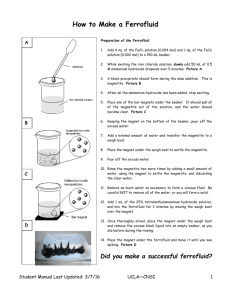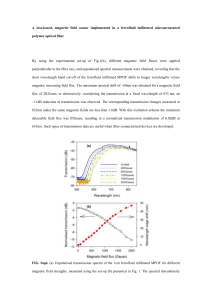Shallow Ferrofluid in an External Magnetic Field by Brayden Hass
advertisement

Shallow Ferrofluid in an External Magnetic Field by Brayden Hass This is a report for the first group project of MCEN 4151, Flow Visualization. For this project I have been working with Kerylyn Lay, Peter Davis, David Oakley, and Jacob Anderegg. Together, we have been capturing photos and videos of ferrofluid under various conditions. The video I have submitted can be accessed on Youtube at the following address, http://youtu.be/A_soOzadtHU. During our shoot, we captured the ferrofluid under a variety of conditions including under the influence of permanent and electro magnets. These images included ferrofluid motion up a spiral shaped steel sculpture and also the formation of the regular patterns of spikes when the fluid is in the presence of a strong external field i.e. the normal field instability. The video I have submitted captures the evolution of this instability as the pool of ferrofluid shallows down to thin film. As this happens the dynamics display several phases which can be understood by examining the energy of the system. The setup we were using to capture my video is a partially completed senior design project intended for display inside the ITL of the University of Colorado at Boulder Engineering Center. A group member, Peter, is working on this project, and so he has access to the setup, ferrofluid, magnets, and other things like the spiral sculptures. The setup for my video is relatively straight forward. There is a stainless steel plate, about 1 foot in diameter, which sits between two large Neodymium magnets. Largest of the two magnets, the top magnet has a plastic shelf to hold it at set heights above the plate of ferrofluid. This is an important part of the setup, this barrier between the fluid and the magnet is essential when using ferrofluids; without it, the fluid would contact directly with the magnet and would be very difficult to separate. Beneath the plate of ferrofluid, the magnet is held so that its dipole is aligned with the dipole of the above magnet thereby increasing the field strength at the plate and changing the field to look as it does in figure 2. The combined field of the magnets forms a football shape which is perpendicular to the plate’s surface. In the video there is a characteristic radius (4 or 5 cm), beyond which the field has no visible effect. At some instances in the video the size varies; these changes reflect the changes in the field as the distance from the lower magnet to the plate changes. As I move the magnet closer, the radius increases and it decreases when the magnet is lowered. We used an 800W bulb with a Chimera lighting kit. This kit is essentially a heat resistant tent box that goes over the bulb and the side facing our magnet setup is white. The light sat about 3 feet from the fluid. Figure 1: Setup: Please note that the camera is slightly above the plate of ferrofluid and points down onto it from a distance of about 40cm. The Underlying Physics Four different energies are determining the dynamics of the ferrofluid. To understand this line of reasoning you must keep in mind what makes up a ferrofluid of this type. Nano particles of an iron compound are covered in a surfactant to keep them from amalgamating together, and are suspended in a carrier fluid. It is a colloidal suspension of solids in a fluid and takes on the characteristics of both components. Exact composition of the fluid we have filmed is not known. The formation of the spikes in the beginning of the video is the typical formation of the normal field instability; these stable spikes can be understood as the lowest energy state of the system. The three energies that will be taken into account are the magnetic field energy (Em), the energy in the surface of the fluid (Es), and the gravitational potential energy (Ep). The magnetic field stores energy in both the surrounding air and inside the ferrofluid according to Equation 1 below. Different materials (especially air and ferrofluid) have different values of magnetic permeability, μ. The relative permeability of the ferrofluid to the air is 2.6 [1]. What this tells us is that the energy stored inside some volume of ferrofluid is 2.6 times smaller than the energy stored in the same volume of air (assuming the same external magnetic field). The fluid flows together in order to increase the volume of ferrofluid inside the regions of strong field. Increasing the volume of ferrofluid displaces the air and directly affects the energy in the surface tension and the gravitational potential energy. An increase in the surface area of the fluid increases the Gibbs free energy of the system according to Equation 2. To give a rough idea of the change in energy when forming a single cone, you need only to compare the surface area of a flat circle, with the lateral surface area of a cone . If the height of the cone is greater than its largest radius, then it comes at the cost of increasing the Gibbs free energy. The use of a cone in this example is an estimate; these spikes which form have been shown to have square and hexagonal cross sections. In addition to the Es, we know that the fluid moving to a higher position above the earth increases the gravitational potential according the Equation 3 below. If the reduction in the magnetic field energy can overcome the cost of increasing the gravitational and Gibbs free energies, then it will flow in the ways which accomplish this. This is the underlying cause of the formations of the spikes. If the field is strong enough, it is energetically favorable for a large portion of the volume to move up to the top magnet. Because the field is strongest in the center, we see that initially single spikes do not have the ability to overcome the Es and Ep barriers; that is until they reach the central field. The droplets lift off the surface as they trade some energy stored to kinetic energy (Equation 4) as it flies upward and stops in an overall lower energetic state. It is the same as a ball on a hill, if given an initial push it will begin exchanging potential for kinetic energy as it transitions between a higher and lower energy state. As the movie progresses the dynamics clearly evolve, but the new behaviors can be understood in the same way as the formation of the initial spikes. ∭ Energy in magnetic field; where B is the magnetic field strength at any point, and μ is magnetic permeability ∬ Energy in surface; ϒ is the Gibbs free energy per surface area at constant temperature, pressure, and particle number Gravitational potential energy; where m is mass, g is the earth’s gravitational acceleration, and h is the height above the earth. The Kinetic energy; m is mass and v is velocity. Changes in Dynamics At the very beginning we see fluid pouring down as the upper magnet is removed; the fluid had gathered there in a previous trial. The magnet is returned to the top position and immediately we see a stable formation of spikes. There is a clear transition as the video continues, the lower magnet is introduced (increasing the field strength) and there begins a flow of ferrofluid from the lower plate up to a growing spikey pool beneath the upper magnet. Our fluid level is continuously dropping throughout the movie, which has a dramatic effect on the dynamics. For one thing the characteristic size of the single spikes continues to drop. Also, I did bring the lower magnet closer at different points (you can tell because the radius of interaction increases) in order to drive the flow harder. In the video it is clear that the flow upwards only takes place at the center of the field. The diagram below shows the magnetic field between two magnets. It is strongest at the center and drops off as you move further out. At some radius we see that the field drops to nearly zero. This is what defines the circle of interaction during the movie. Examining the field lines we see that this makes sense; the outer lines point in the opposite direction as the inner field lines, as they are vector quantities, they tend to cancel one another. The facts that the field increases at the center and energy associated with the field is goes by the field strength squared, having ferrofluid in this region is more energetically favorable than having it at the edge of the circle. Droplets form by overcoming the Es associated with separating from the fluid body. When they separate they have surface tension holding them to the metal plate. Driven by the gradient in the field, they trade for some kinetic energy and move toward the center. Throughout the movie you can see that the density of the spikes increases toward the center. Individual spikes can be seen accelerating inward and shuffling in to the central region before being lifted off the surface. At the very center the single spikes are in a strong enough fields to be taken from the plate, thus overcoming the force of gravity and surface tension pulling them down; all this is to reach the highest field density near the top magnet. Once in the upper pool, they have completed their transition between the high and low energy states. Other interesting, more subtle, dynamics happen during the movie. For instance at about time 00:15 s the lower magnet is raised and the spikes reduce in size, increase their flow rate toward the center, and the size of the circle increases. The field in the plain of the fluid has been increased, so there is a stronger drive toward the center. Individual drops form and are lifted from a further radius. I would like to note that the video is slowed down during 00:24 to 00:31. As the amount of fluid continues to drop we see that the spikes are losing size. While moving toward the very center the individual spikes do not combine; I believe they do not have a strong enough dipole moment to combine with each other. Once in the center, the strong field and the incoming flow from all directions allows them to combine and stack into tall central spikes that can then overcome the gravitational barrier. Once the conditions are right, at around 00:52 s, a steady flow of fluid occurs at the very center. Moving the lower magnet out of alignment was enough to break this steady flow. Finally we see that there is not enough fluid to maintain a rapid flow. The drops are so small and drag forces are slowing them way down, it takes longer and longer for enough fluid to reach the center and overcome gravity, and it changes to a slowing periodic flow upwards, drop by drop. http://en.wikipedia.org/wiki/Force_between_magnets Figure 2. To film this we used a Cannon 7D shooting with a Canon EF Macro 100mm f/2.8 lens. The video was shot at 30 frames/second. We rented a setup for diffuse lighting with an 800W bulb to make sure the fluid was well lit with white light. Other lights in the room were turned off during the shoot. The field of view during the movie is around 12 cm and the focal length was around 40cm. I wanted to focus in on the behavior of the droplets forming and them rising up off the surface. The only editing I did to the clip was to add the text in the beginning, the music, the fading and to slow down the section mentioned earlier. My video reveals some interesting dynamics which result from an external magnetic field being applied to a shallow pool of ferrofluid. I had seen this sort of behavior when we first started setting up and I knew it was what I wanted to capture. Ideally there would have been a larger depth of field; it would have been nice if all parts of the flow were in focus. Also, I think if we had multiple lights then we could get multiple reflections coming off the fluid and that may help in visualizing the flow better. Bibliography: [1] Franklin, Thomas A. “Ferrofluid Flow Phenomena”. Massachusetts Institute of Technology, June 2003. http://dspace.mit.edu/bitstream/handle/1721.1/16937/53225503.pdf?sequence=1 [2] Muller, Hanns Walter, and Mario Liu. “Ferrofluid Dynamics”. Springer-Verlag Berlin Heidelberg, 2002.



